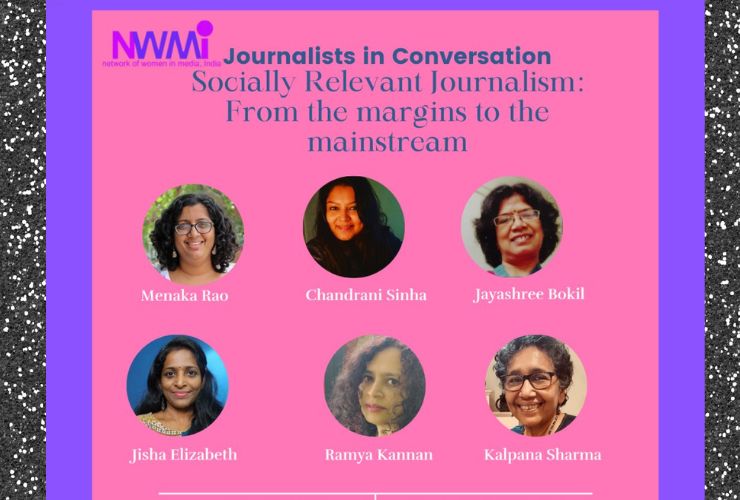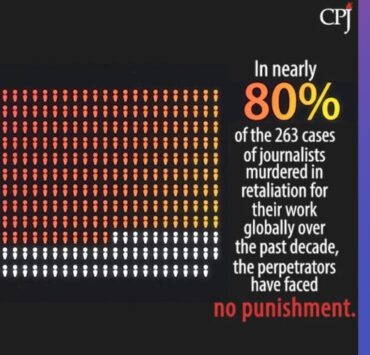
By Annie Philip

How did so-called ‘soft’ beats like health and environment come to occupy centre stage after being marginalised over the years? This question was discussed in the online panel discussion ‘Socially relevant journalism: From margins to mainstream’ organised on the third day of the 20th anniversary celebrations of the Network of Women in Media, India. The session explored how the pandemic and climate change had forced a recognition that these beats – often covered by women, and by freelancers – were of critical global importance. “The so-called soft beats are the ones that require the most work [and this] often goes unacknowledged,” said moderator Kalpana Sharma as she introduced the session. Beats like politics or business are considered more seriously within the media, she said.
Sharma traced the growth of coverage of environmental issues in the media, starting with Himmat where she worked during the 1970s. She collaborated with a group of environmental journalists and activists on the Centre for Science and Environment’s State of India’s Environment 1982: A Citizens’ Report, covering energy, land, water, forests, health, and the impact of policy on people. By the 1980s, The Indian Express had a designated Development Correspondent, Sevanti Ninan, and the paper gave space for writing on environmental issues. Over time, other papers also appointed correspondents for agriculture, labour, health and environment.
“Things changed very drastically in the 1990s as news came to be defined as something that should sell the newspaper,” Sharma said. “Once the newspaper is viewed as a profit centre, the focus of coverage even on these kind of issues changes.” Health became ‘wellness and lifestyle’ as that is what the market dictates. Similarly, environment became a matter of ‘personal choices’. Sharma pointed out that the media published many reports on questions like the importance of open spaces, and bicycling in urban areas, but not so many on major concerns such as the sources of pollution, the environmental damage done by landfills, or the culpability of private industries in dumping toxic waste and poisoning the groundwater. Nor was there sufficient writing on the large infrastructure projects that affect biodiversity and the livelihoods of the poor. Instead, there was more writing on issues of interest to the urban middle class.
The pandemic has been a wake-up call. All of a sudden, health, which had been designated as a soft beat, became the most important one. “We have seen that informed reporters writing on health, who understand the science, economics and politics of healthcare, are the ones who have done the best reporting,” said Sharma. “Coincidentally or otherwise, most of them are women.” She invited the speakers to share their experiences of writing on these issues.
Pune-based Jayashree Bokil said her first report in 2001 of a leopard straying into the city spurred her entry into environmental journalism. She wrote a number of stories on this particular incident, which eventually led to more in-depth writing on the environment. Environmental journalism is her passion, but she doesn’t get to spend enough time doing on-ground reporting as she handles other beats as well.
Bokil said she was fortunate to find subject experts in Pune who are multilingual, which is a big help when doing science reporting in languages other than English. Journalists’ bodies recognise the importance of making science accessible in regional languages. For example, the local union had, with the assistance of the India Meteorological Department, Pune, translated a list of nearly 300 commonly used meteorological terms into Marathi during the pandemic, and plans to publish it.
Chennai-based Ramya Kannan spoke about how fellowships helped shape her work in health journalism. “This is a field where there is so much jargon already and we have to break it down for our readers.”
Quoting a scientist who said the pandemic has been the revenge of science, Kannan said she felt it has also been the ‘revenge of health, environmental and development reporting’. “These fields have come back to the main pages. If they have never been there, they have been dragged on to the main pages.”
Speakers pointed to the wide range of health stories covering Covid-19 — on vaccination, on vaccine access and equity, on the health system’s ability to provide non-covid care, on violence against women during the pandemic, and so on – carried in the form of lead stories, thematic series and explainers, across media. “Since these stories were on Page 1, men also wanted to write them,” said Kannan. “Non-health reporters started reporting on health issues…everything revolved around Covid.”
However, the new attention on public health could recede with time, said Sharma. As Kannan pointed out: “The challenge now is to keep these stories on the front page, to continue to give these beats significance.”
Speaking on health journalism before the pandemic, Menaka Rao noted that health reporting has largely consisted of writing on unusual medical cases or surgeries. Health is not an issue in election campaigns. Rao was unprepared for the ‘fall’ in importance when she switched from legal to health journalism. She pointed out that good health writing requires both training and experience. “Writing on health is a steep learning curve,” she said. The journalist has to understand different government programmes on the go. Rural reporting helped her understand social inequities better, she said.
Going freelance has helped Rao explore different stories – for example, she has worked on podcasts on tuberculosis for Suno India — but freelance journalism needs financial backing. Rao also touched upon the difficulties of reporting as a freelancer without an identity card.
Chandrani Sinha, based in Guwahati, spoke on how she “looked for the overlooked” factors in environment and gender while covering regular stories, which is how she approached her story on the Brahmaputra. It took her almost 10 years to develop stories around environment, wildlife and conservation in the river’s vicinity. Sinha’s experience in political reporting helped her. “I could understand the nitty-gritty of politics involved in conservation and environment… and how it is involved in the narrative.”
Sinha reminded the panel that environmental journalists should be reporting on the ground situation. The northeastern part of India is often viewed as a homogenous unit, but it has a lot of different landscapes, geography and cultures. This is something that reporters need to take into consideration, for example when highlighting how climate change has affected the northeast region and led to erratic weather.
Sinha took to freelancing because she could not find the space to write about important aspects of the environment and climate change. As a multimedia journalist, she has enhanced her skills and found platforms for different media. Her tip for those who wish to venture into freelance writing: Have plenty of savings to take you through the low periods.
Jisha Elizabeth said reporting on Cyclone Ockhi in 2017 was the turning point in her career, leading her to delve deeper into environmental journalism. She showed a video of her work, in which she reported on environmental disasters, sand mining, climate change, and infrastructure projects affecting communities, in the background of corruption, bureaucracy and the state-corporate nexus. Elizabeth also spoke about the dangers faced by journalists. These included defamation suits, threats to their lives and employment, and cyber-attacks. Journalists have been slapped with fake cases when their investigations threaten powerful groups. She added that her media organisation gives space to such stories, but this isn’t the case with other media outlets which face pressure from corporates. Finding reliable sources in the beat is also difficult, she said. Alternate media outlets do a better job of covering the environment, but they face funds shortages and constant surveillance from the government. Elizabeth also highlighted the role of PR companies in pushing agendas.
The panelists’ concluding thoughts brought one back from specialised beats to the challenges of the media landscape. How do we improve reporting amidst job losses and financial cuts in the media industry? We will have to think of cultivating citizen reporting, said Kannan. The media is evolving as journalists take on multiple roles.
View the complete discussion here:
SPEAKER PROFILES:
CHANDRANI SINHA is an independent multimedia journalist based in Guwahati, Assam. She has written on climate change in conflict areas, and has been reporting stories from Northeast India for the past 10 years.
JAYASHREE BOKIL is a journalist with Dainik Bhaskar and Divya Marathi, and has been a journalist for the last 20 years, having worked in Pune and other parts of Maharashtra. She reports on the environment, and other areas.
JISHA ELIZABETH is an environmental journalist and a senior sub editor with Madhyamam. She is an executive member of the Kerala Union of Working Journalists.
MENAKA RAO is an independent journalist and podcaster who writes on issues related to health and law. She is Consulting Editor with the podcasting platform Suno India and tweets from @menrao.
RAMYA KANNAN is The Hindu’s Tamil Nadu bureau chief. She has reported on health and development issues for nearly 25 years.
MODERATOR:
KALPANA SHARMA is an independent journalist, columnist and author. Her focus areas are gender, environment, development and the media.




